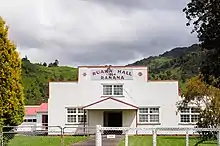Ranana
Ranana is a settlement 60 kilometres (37 mi) up the Whanganui River from Whanganui, New Zealand.

Originally known as Kauika, it grew after 1848 as local Māori moved out of fortified pā settlements in peacetime.[1] It was renamed by the missionary Richard Taylor in 1856 for Rānana, a Māori transliteration of London.[2] The town's Catholic church, built in the 1880s for the hapū Ngāti Ruakā of the iwi Te Āti Haunui-a-Pāpārangi, is still in use.[2][3] Nearby is Moutoa Island, site of a famous battle in 1864.[4]
Ngāti Ruakā and Ngāti Hine Korako have two traditional meeting grounds in Ranana: the Rānana or Ruakā Marae and Te Morehu meeting house, and Te Pou o Rongo Marae and Tūmanako meeting house.[5][6]
Education
Te Wainui a Rua is a co-educational state primary school for Year 1 to 8 students,[7] with a roll of 36 as of April 2023.[8]
References
- Walton, A. (1994). "Settlement Patterns in the Whanganui River Valley, 1839–1864" (PDF). New Zealand Journal of Archaeology. 16: 123–168.
- Beaglehole, Diana (20 March 2014). "Whanganui places: River Settlements". Te Ara: The Encyclopedia of New Zealand. Retrieved 17 November 2015.
- "Rānana (Ruakā)". Māori Maps. Retrieved 5 December 2015.
- "Moutoa Island - War in Whanganui". New Zealand History. Ministry for Culture and Heritage. 25 June 2014. Retrieved 18 November 2015.
- "Te Kāhui Māngai directory". tkm.govt.nz. Te Puni Kōkiri.
- "Māori Maps". maorimaps.com. Te Potiki National Trust.
- "Ministry of Education School Profile". educationcounts.govt.nz. Ministry of Education.
- "Education Review Office Report". ero.govt.nz. Education Review Office.